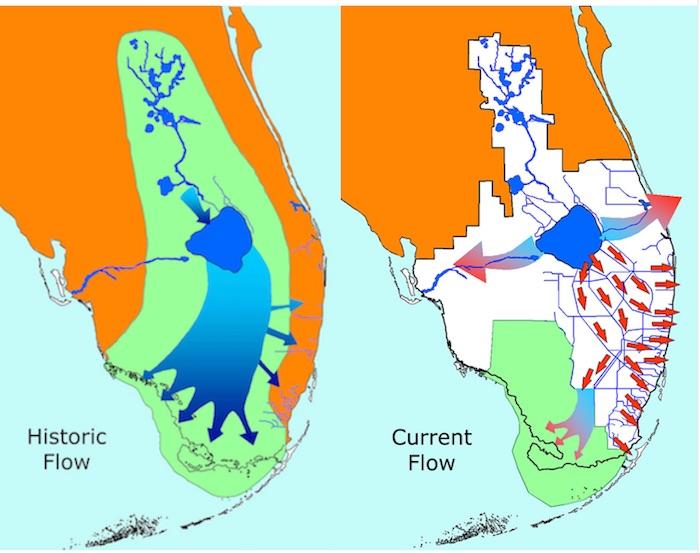
“Here are no lofty peaks seeking the sky, no mighty glaciers or rushing streams wearing away the uplifted land. Here is land, tranquil in its quiet beauty, serving not as the source of water, but as the last receiver of it. To its natural abundance we owe the spectacular plant and animal life that distinguishes this place from all others in the country.” -President Harry S. Truman's Dedication to Everglades National Park in 1947.
As a native from Miami, I grew up drinking some of the cleanest tap water in the state, all because of the the Everglades' contribution to our natural aquifer system. A slow-moving river mainly comprised of sawgrass marsh, the Everglades (literally meaning “forever grassâ€) is affectionately nicknamed the River of Grass. It is South Florida's main source (and receiver) of freshwater and sanctuary for countless wildlife and plant species, many of which are endangered or threatened. Historically, the nine unique habitats that make up the Everglades comprised 11,000 square miles of pristine land. However, human intervention for agricultural development and real estate left more than half of this land drained and the natural flow of water destroyed. Even so, this fragile land not only provides habitat to crucial flora and fauna, but also contributes immensely to the overall economy of the state through tourism and recreational activity.

Being as fragile and important as it is, you probably have never thought the Everglades and oil drilling would show up in the same sentence. That's right. In this interactive map, you can see the locations of active oil wells throughout Florida. Massive oil exploration has already been underway in Big Cypress National Preserve (one of the many protected and delicate areas of the Everglades) and has caused irreparable damage to the soil and vegetation.
The threat of oil drilling
Drilling for oil is so much more than just sticking a pipe in the ground and extracting oil. The process requires that land be paved in order to bring in the trucks and equipment. To extract the oil, drilling passes through the aquifer system and deep into the oil reservoirs. As Florida sits on a bed of limestone, its porous nature makes it vulnerable to contaminants and/or litter in the runoff or oil leakage directly into the aquifer, thus compromising our pure drinking water.

An old problem resurfacing
This alludes to the recent news of more oil exploration and drilling in an area just 50 miles north of the Everglades National Park. While it is not technically within the park, this area is still considered part of the River of Grass (Water Conservation Area in the map below) and will more than likely impede any restoration efforts to improve the flow of water. In other words, instead of nurturing a sick land, the First District Court of Appeal (FDCA) has elected to worsen its conditions.
New targeted area
Directly east of Big Cypress National Preserve is Water Conservation Area-3 (WCA-3), the new proposed site for oil drilling. The integrity of WCA-3, and the other water conservation areas, are important contributors to the overall health of the River of Grass system. WCA-3 not only has areas dedicated to wildlife preserves for endangered animals and recreational activities, but also plays a significant role as a buffer between the Everglades and residential development. For example, it aids in the protection of runoff into the Everglades as well as being extremely important to prevent floods into developed areas. Because of this, drilling for oil here has the potential to disrupt the buffer, leaving the aquifers vulnerable to potential oil leakage or contaminants in the runoff.
Is there hope?
Oil drilling will certainly be devastating for the already fragile ecosystem that is targeted. The damage that has been evident from oil exploration and drilling in Big Cypress National Park could prove devastating if repeated in WCA-3, or any other part of the Everglades. While the FDCA has approved the oil drilling permit, a decision from Broward County (the county directly east of the drilling zone) is still pending. For the future prosperity of Florida's ecosystem, economy, and drinking water quality, we can only hope the decision is favorable.
About the Author
 |
Kristen Dominguez is a PREP Scholar in Infectious Diseases studying tick phylogenetics and their bacteria at the University of Georgia. When not pipetting her day away in lab, she likes to spend her time drinking Cuban coffee, enjoying wine, strolling through nature trails, or back home (Miami) in the middle of the ocean. More from Kristen Dominguez. |
About the Author
-
athenssciencecafehttps://athensscienceobserver.com/author/athenssciencecafe/April 17, 2020
-
athenssciencecafehttps://athensscienceobserver.com/author/athenssciencecafe/April 12, 2020
-
athenssciencecafehttps://athensscienceobserver.com/author/athenssciencecafe/April 3, 2020
-
athenssciencecafehttps://athensscienceobserver.com/author/athenssciencecafe/March 30, 2020







